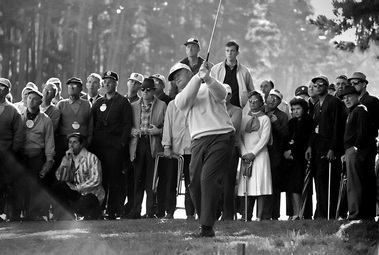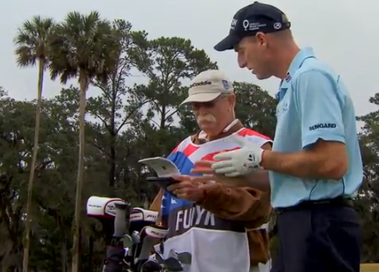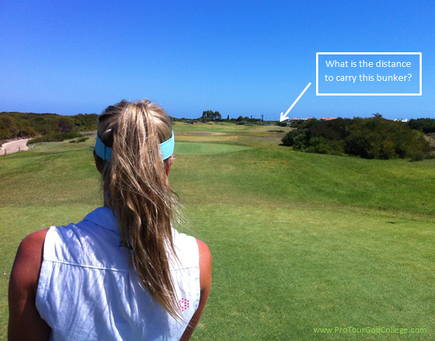"When I prepared properly, then all I had to do was control myself and put myself in a position to win by sticking to the game plan" - Jack Nicklaus  1964 Crosby Pro-Am Photo: Monterey County Herald The course management plan starts well before you even get to the course during tournament week. As Jack Nicklaus did during his career and others have followed, he rarely played a tournament the week before a major. He didn't take the week off but rather turned up to the tournament course early and did his course preparation. He started charting golf courses in 1961 at the US Amateur at Pebble beach which he won. "When I prepared properly, then all I had to do was control myself and put myself in a position to win by sticking to the game plan" As I mentioned the planning starts before tournament week. An assessment of your equipment make up is the first thing that you should look at. What I mean by that as an example is do you need an extra wedge (like Tom Kite who carried four wedges) in the bag to fill in the distance gaps especially when the par fives are unreachable? Or the course has plenty of shorter par fours that require precise distance control with your approaches. Possible change to the bounce of your wedges for harder conditions (less bounce recommended) and more bounce for wet conditions or the sand in bunkers are very fluffy and soft. Another consideration is adding another rescue club in place of a long iron when the greens are not receptive to long irons coming in low or if the rough is thick as rescue clubs glide through the rough much easier to use then a long iron. A heavier putter for slow greens and vice verse for fast greens is something you can look at. In 1976 Raymond Floyd at the US Masters added a 5 wood to his bag and left his 2 iron out so that he could hit his second shots into most of the par fives and hold the green. Well not only did he win but equaled the tournament record at the same time.  The next important task is to get or make a yardage/meterage book and check all distances are accurate. These days there are no excuses as laser devices make that task hassle free. In Nicklaus's days pacing or stepping out the course was the done thing until measuring wheels was later used. Now gathering local information like prevailing winds need to be added as certain locations on the course being able to judge the wind can be very tricky and difficult to pick especially when large trees can make the wind swirl and confuse you. Mark each page of the book with an arrow indicating the direction of the prevailing wind. All courses have certain idiosyncrasies that when reveled can make a big difference and to find this out ask the local professional.Things like where putts tend to break and where pin positions are favored can be very valuable information to test out in practice rounds and apply in tournament rounds. From the tee always get a measurement to the start of all fairway bunkers (or other hazards) and also the distance to carry them. This is necessary as tee markers can be moved closer on some days and that could bring the hazards into play or allow you to carry over the them when the conditions are favorable. Note also which side of the fairway gives you the best look to the green.  For your approaches into the green the distance to the front edge is a given but always get a second or third "front" measurement when there are bunkers guarding the front. So the front of the green when the pins are tucked behind the hazards are much further then the actual front edge so you can take the right club to attack the pin when you have your 'A' game going. And when you don't the center of the green is the percentage play. The one thing you should always do is divide the green into four quadrants. By doing this you can map each quarter by gradient and which way the grain of the grass grows and is going to influence your putts. This will help immensely with reading the greens to get the correct line and speed of the putt. Mapping the slopes and plateau of each green helps you to not always go at the pin. The safer option is to use the slope or backstop (slope behind the pin) to guide your ball closer to the hole especially when the pin is in a "sucker" position enticing you to go for it and the penalty of a double bogey or worse if you miss the shot. Most amateur and professional's that I know have a plan of how they would play a course but most seldom stick to that game plan. It's always easy to stick to the plan when things are going well but can you do it when your round is not going how you want it to? Like all areas in your game it's how well you prepare and under pressure "Trust the Process" and that includes executing your game plan that will give you the best chance to post a competitive score over four rounds. It's of no use if you do it sometimes because it will break down when you need it to work in the tournaments that are of importance to you. As Jack Nicklaus said "The difference between being nervous and scared is being prepared". He should know as no one has done it better than him! David Milne and Lawrie Montague - Pro Tour Golf College Your Success On Tour is Our Business Comments are closed.
|
Archives
June 2019
|
Proudly Supported By
Copyright © 2011 - 2018 Pro Tour Golf College
Website Managed By Golf Performance Media
All Rights Reserved
Website Managed By Golf Performance Media
All Rights Reserved

 RSS Feed
RSS Feed



